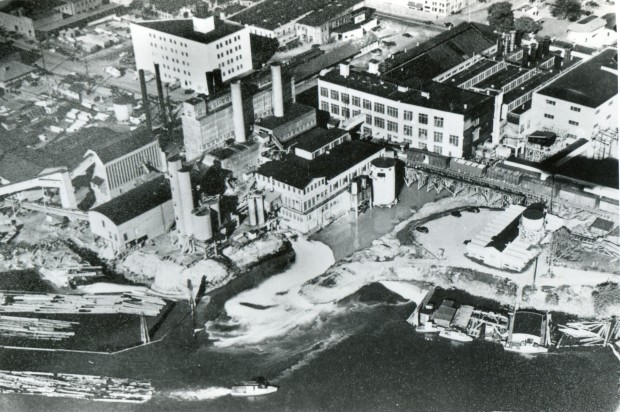Archive for category Pulp & Paper Industry
Field trip to the former Boise Cascade Mill in Salem, OR
Posted by jvhillegas-elting in Beyond the Dusty Archives, Industries, Pulp & Paper Industry, Salem on December 16, 2017
To investigate and understand better historical landscapes, in September 2017 I took a field trip to Salem, Oregon, to discover what visible evidence might remain of the pulp and paper mill that used to exist in downtown Salem.

Aerial view (from the southwest) of the Oregon Pulp and Paper (later Boise Cascade) mill in Salem, 1949. Pringle Creek runs under the mill and railroad bridge at center, carrying untreated effluents into Willamette Slough, and then left (north) into the Willamette River. By the early 1970s, effluents were retained in ponds on Minto Island, west of the mill just beyond the frame at the bottom of the image. Willamette Heritage Center, P 2012.049.0115.
The mill began operations in 1920 as the Oregon Pulp and Paper Company, under the holding company Columbia River Paper Company. In 1962 the Boise Cascade Corporation took over. The mill ceased operations in 2007. In 2015, the South Block Apartments opened on the former mill site.
Read the rest of the entry to see my photos and learn a bit more . . .
Dioxin and Willamette River Pollution: A First Step Into the Toxic Waters
Posted by jvhillegas-elting in Industries, Policy & Politics, Pulp & Paper Industry, Science, Superfund, Toxics, Willamette River watershed on May 20, 2012
[Originally published on my blog Historical Threads on May 18, 2011. This version has been refined & corrected, where necessary.]
This post provides some preliminary research and analysis on dioxin pollution in the Willamette Watershed connected to pulp and paper mill effluents.
I was recently at an environmental history conference and found myself in a discussion with someone doing research on dioxin pollution from pulp and paper mill effluents. As we were sharing stories, I realized that I had not seen a single reference to the word “dioxin” in any of the government reports, newspaper articles, professional journals, letters, or other primary sources from the 1900s into the 1960s that I have consulted thus far. Over the past few weeks, I’ve searched various primary and secondary sources, with the goal of determining just when dioxins became a known toxin, and when they were linked empirically with pulp and paper mill effluents, to determine if I had inadvertently missed something very important (and would have to re-write my thesis), or if this type of pollution hadn’t been discovered until after the 1960s (and I was OK).
Here is what I have found thus far . . . Read the rest of this entry »
Sixty years later, a prediction comes true . . . sort of.
Posted by jvhillegas-elting in Industries, Pulp & Paper Industry, Willamette River watershed on April 30, 2012
[Originally published on my blog Historical Threads on Sep. 27, 2011. This version has been refined & corrected, where necessary.]
This is fascinating: Metro is considering bidding for the recently-closed Blue Heron paper mill site in Oregon City at the base of Willamette Falls.[1] It would be great to have public access to this part of the river.
On another note, it appears that mill officials might have been correct when they predicted in 1949 that more stringent Willamette River water quality standards would run them out of business. However, does it count that the prediction was sixty years in coming to fruition, or that more stringent water quality standards do not entirely explain the demise of the mill?
